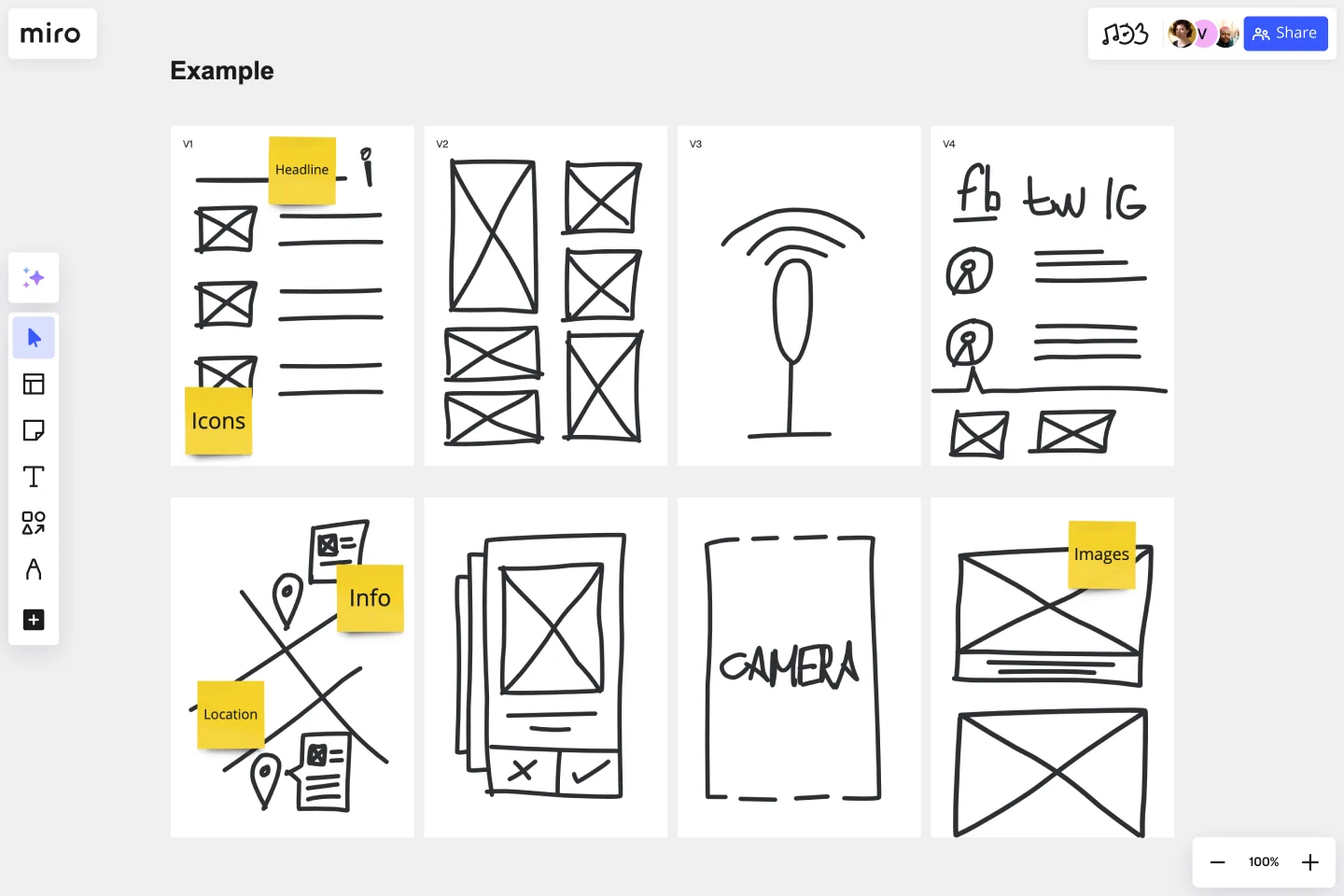Crazy Eights Template
Run wild with this Crazy Eights Method! Perfect for generating tons of ideas—fast! It is a design thinking method bringing unique perspectives in a visual idea to communicate your ideas.
About the Crazy Eights Template
What is Crazy Eights?
Crazy Eights is a quick and dirty sketch brainstorming exercise that challenges team members to sketch 8 ideas in 8 minutes. It keeps participants on their toes, forces quick thinking, and doesn’t allow time to weed out “bad ideas.” This is about quantity over quality and is a great way for your team to let loose and really push the boundaries of what’s possible.
When to use it
Crazy Eights is best used at the beginning stages of ideation. Keep the sessions small, just six to eight people. Whether you’re looking to redesign a website, the UX on a page, or even rebrand your company logo, it’s an effective way to kick-start the process.
How to use the Crazy Eights Template
Flexing your creative muscles has never been easier with Crazy Eights. Perfect for early stages of development, this ideation technique is a favorite for its fast-paced, time-boxed energy.
Step 1: Head to your Crazy Eights Template—since you’re working with distributed teams, we’ve generated a digital space with 8 clean boxes to make it simple.
Step 2: Use the Miro template. Using the 8 boxes in the Miro template, tell your team they have 8 minutes to sketch, draw, and ideate using the pen tool (or any other tool!) provided by Miro. This is not about perfection, but about output. Sketches can be as rough as you need!
Step 3: Make sure someone is keeping time. The timekeeper should update the team often so they can keep track and avoid wasting too much time on a single sketch.
Step 4: Repeat as many times as you want.
Step 5: Ask team members to present their top 3 ideas to the group. They should choose their 3 favorite ideas. Give them 6 more minutes to sketch out these ideas further. Then they can present them to the group.
Step 6: Vote! Using the voting tool provided by Miro, create a border around each board and dot vote.
What are the benefits of using the Crazy Eights for Brainstorming?
Crazy Eights is perfect for getting your own creative juices flowing during a brainstorm and drawing out ideas from colleagues. It’s short and fun—and most important, helps generate ideas. Not all of them will be great, but you can iterate, revise, and shape—as you and your teammates inspire each other.
When do I use the Crazy Eights for Ideation?
Crazy Eights is best used at the beginning stages of ideation. Keep the sessions small, just six to eight people. Whether you’re looking to redesign a website, the UX on a page, or even rebrand your company logo, it’s an effective way to kick-start the process.
Get started with this template right now.
Empathy Map Canvas by Sampriti Jain
Works best for:
Market Research, Strategy & Planning
The Empathy Map Canvas template allows you to explore user behaviors and emotions comprehensively. It’s designed to help you visualize user experiences and create solutions that truly meet their needs. Perfect for UX teams and product developers.
Filmmakers Storyboard
Works best for:
Storyboard, Design, Planning
Bring your film projects to life with the Filmmakers Storyboard template. Designed for directors, producers, and cinematographers, this template helps you plan every aspect of your film, from scene composition to shot sequences. It includes detailed sections for visual elements, camera angles, and dialogue, ensuring a smooth production process. Use this template to create a clear visual guide that communicates your vision and enhances collaboration among your film crew.
Design Research Template
Works best for:
UX Design, Design Thinking, Desk Research
A design research map is a grid framework showing the relationship between two key intersections in research methodologies: mindset and approach. Design research maps encourage your team or clients to develop new business strategies using generative design thinking. Originally designed by academic Liz Sanders, the framework is meant to resolve confusion or overlap between research and design methods. Whether your team is in problem-solving or problem space definition mode, using a research design template can help you consider the collective value of many unrelated practices.
Idea Funnel Backlog
Works best for:
Design, Brainstorming, Agile Workflows
An Idea Funnel Backlog enables you to visualize your backlog and restrict the number of backlogged items at the top. In doing sos, you can prioritize items on your list without having to engage in unnecessary meetings or create too much operational overhead. To use the Idea Funnel Backlog, break up the funnel into different phases or treat it like a roadmap. Use the Idea Funnel Backlog as a hybrid model that combines your roadmap and backlog into one easily digestible format.
Buyer Persona Template
Works best for:
Marketing, Desk Research, User Experience
You have an ideal customer: The group (or few groups) of people who will buy and love your product or service. But to reach that ideal customer, your entire team or company has to align on who that is. Buyer personas give you a simple but creative way to get that done. These semi-fictional representations of your current and potential customers can help you shape your product offering, weed out the “bad apples,” and tailor your marketing strategies for serious success.
iPhone App Template
Works best for:
UX Design, Desk Research, Wireframes
Incredible percentages of smartphone users worldwide have chosen iPhones (including some of your existing and potential customers), and those users simply love their apps. But designing and creating an iPhone app from scratch can be one seriously daunting, effort-intensive task. Not here — this template makes it easy. You’ll be able to customize designs, create interactive protocols, share with your collaborators, iterate as a team, and ultimately develop an iPhone app your customers will love.
